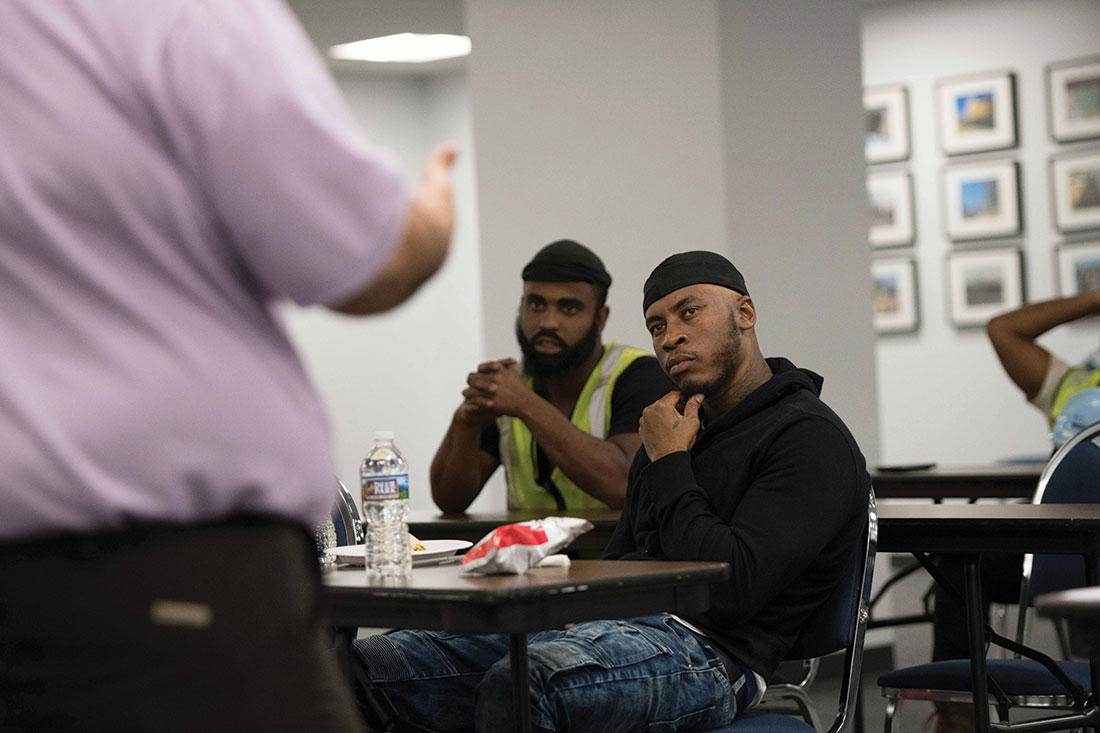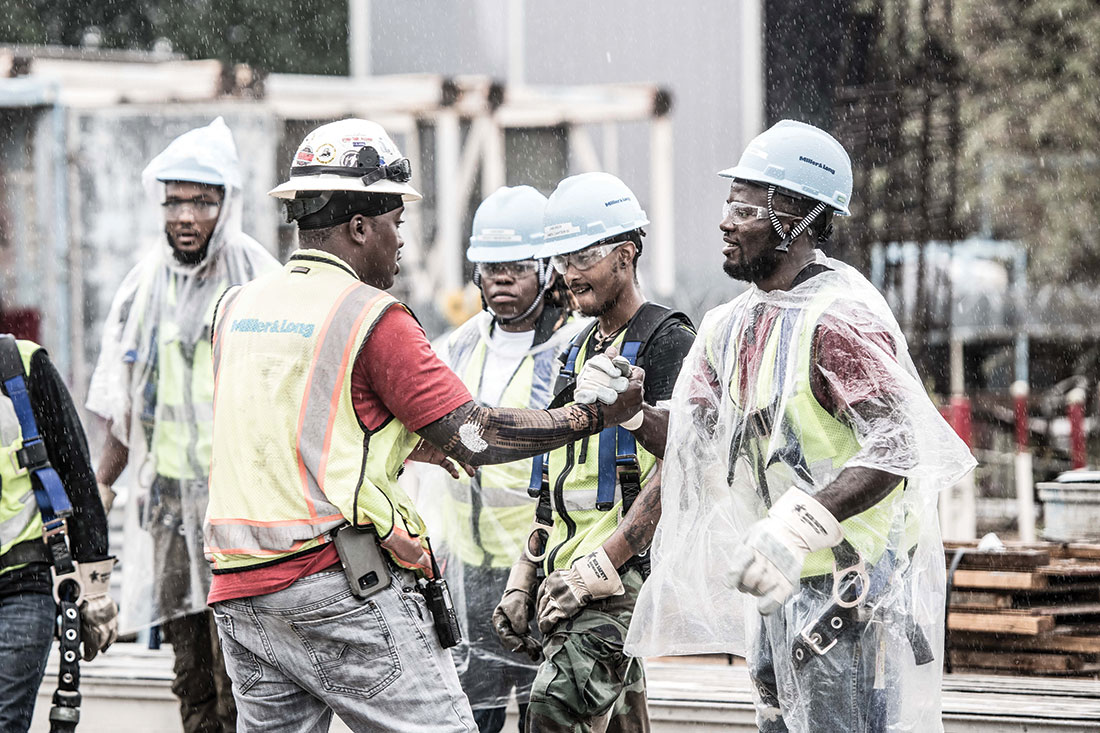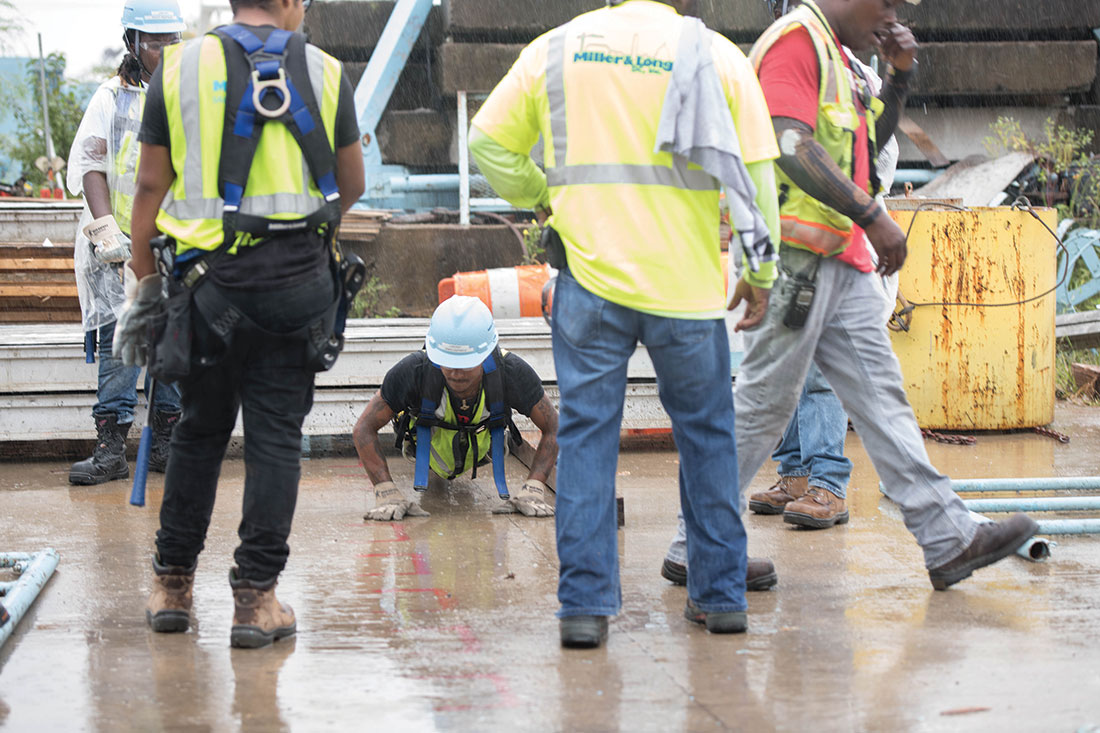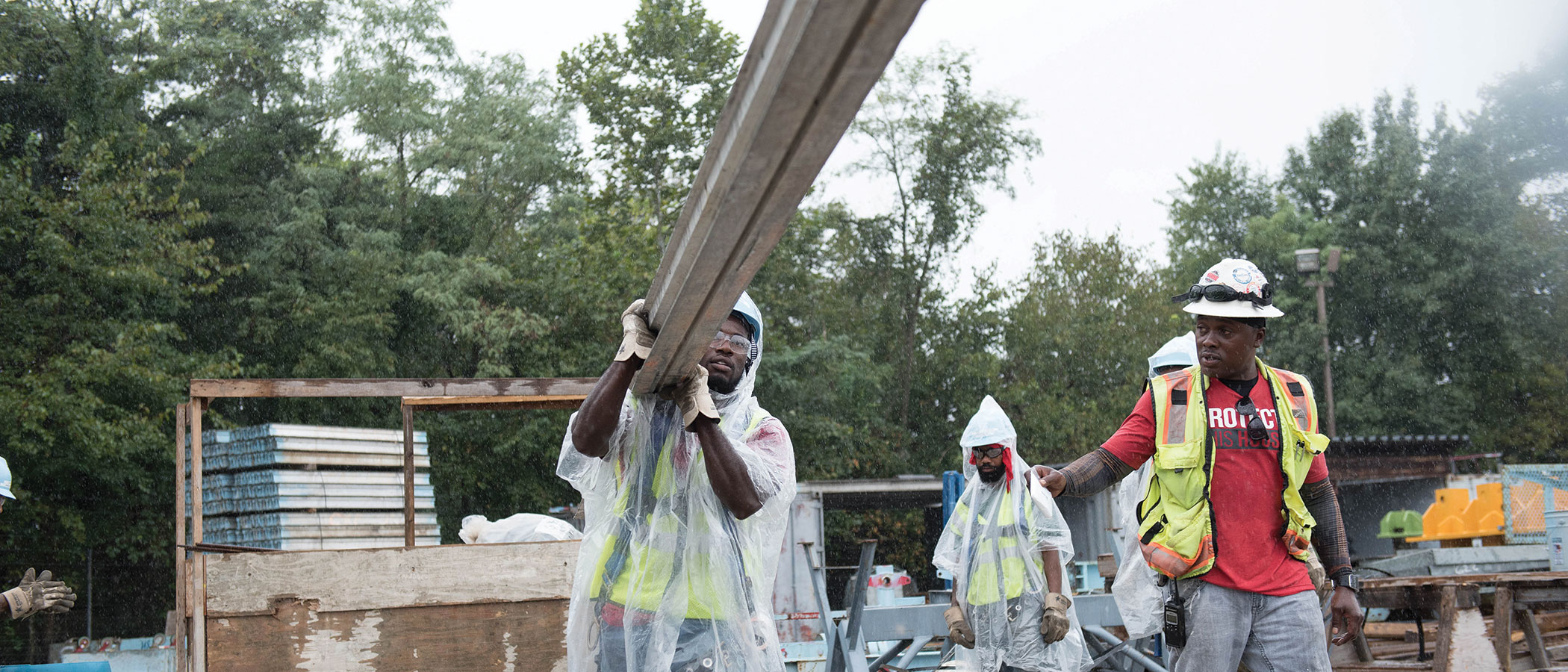Miller & Long Concrete Construction has a long-standing commitment to workforce development and training through its existing pre-apprenticeship programs. It recently added to its efforts to expand the pool of qualified laborers in the construction industry through a program supported by the Department of Employment Services. In Part I of a two-part series, JOBS Coalition Pathways highlights the bootcamp training component of this 12-week pre-apprenticeship program and how it helps prepare those new to the construction field for future career success.
It’s an overcast fall morning at “The Yard,” Miller & Long’s 22-acre maintenance and storage facility in Prince George’s County that unassumingly rests alongside a narrow stretch of Westphalia Road. Despite steady showers, a small team of laborers-in-training braves the weather to makes its way to the grounds, where there are stacks of metal beams. The group of eight — seven men and one woman — are wearing powder blue hardhats, neon yellow safety vests, work gloves and heavy-duty work boots, well-suited for the rain slicked concrete.
One-by-one, each person steps up to a beam and conducts the balance test. Then, hoists an 82- to 94-pound beam, over one shoulder — with team members spotting for safety. “Spinning, spinning, heads up,” announces one young man, as two instructors carefully watch nearby. After moving the beams, or 21s, the group transitions to the next project: building scaffolding.
At Miller & Long, a company that has long provided its own pre-apprenticeship training for the hard-to-employ, training bootcamps like this are the first stop for construction trade newcomers to gain crucial hands-on experience before transitioning into the field. It’s the same path started months earlier by a separate class, one that is part of a 12-week pre-apprenticeship program by Miller & Long with support from the Department of Employment Services. That inaugural class graduated on September 30, the end date of the program.
“Workforce development and training is for the common good of the community,” says Otto Girr, vice president of Human Resources at Miller & Long. “We are helping to strengthen employment opportunities through outreach to areas of the city with high unemployment where residents are most in need, including those fresh out of prison who have a hard time finding a career path.”
According to a Request for Applications (RFA) earlier this year, the DOES Office of Workforce Development announced it would be seeking applications for a maximum $150,000 grant for “organizations to develop and implement a comprehensive pre-apprenticeship program that features work-based job training for residents ages 18 years or older” in an effort “to expand innovative programming and meet the demands of District residents.”

The pre-apprenticeship program starts with a two-week bootcamp and continues with 10 weeks of immersive, on-the-job training with trainees dispersed to three different sites across Tysons Corner, Virginia, Washington, D.C., and Bethesda, Maryland. The program also incorporates safety and professional development classroom trainings, covering topics ranging from conflict resolution to budgeting and other money matters. The goal? To help participants “stay employed and avoid pitfalls,” says Girr.
“The objective was to make sure we have a group of pre-apprentices that are given all the tools and training necessary to help them succeed to create a career in construction,” adds Romina Byrd, the company’s director of education and training.
First Stop, ‘The Yard’
Miller & Long hired 28 students to start as pre-apprentices, their journey beginning with 7 a.m. calls to The Yard. There, trainers William “Moe” Smith and Stanley Spencer teach “the basics” needed to survive on the job as laborers, like building scaffolding, carrying 21s, learning the names of and identifying construction tools and materials — all with safety in mind.

“Construction is a dangerous job, period,” stresses Smith, a senior carpenter foreman with Miller & Long, who is also the bootcamp’s “commander.”
For participants, solid OSHA (Occupational Safety and Health Administration) training is key to ensuring safety for themselves and their peers.
“We tell all our trainees and guys in the field, ‘The way you came to work with all your limbs is the same way we want you to go home,’ ” he says.
To reinforce a safety first mentality, Smith conducts on-the-spot quizzes. Between projects during the “military-style” sessions, he assembles students then fires off questions:
“Prior to being tied off, what is the rule? At what height do you have to be tied off?”
“Six feet,” a student responds.
“Six feet, my man,” Smith says with a smile, adding, “When your foot is getting ready to hit 6 feet, you better be tied off already.”
A correct answer is rewarded with positive reinforcement of dap. And a wrong answer reaps pushups. Smith explains that the rigors of the bootcamp mentally and physically prepare trainees for what to expect on the job site so they can survive. Missing more than two days warrants dismissal from the program, and each participant must have the mental stamina to take the instructor “whooping and hollering” in his or her ear. “I’m not going to make it easy for you because it’s not going to be easy when you go into the field,” he says. “It’s fast-paced and you have to be able to [keep] up.”

Facing Challenges Head On
According to Smith, communication is the biggest challenge facing those entering the field. In a diverse industry like construction, the presence of language barriers, as well as cultural stereotypes, can impact on-the-job performance.
That’s why it’s important to always be “an asset and stay in attack mode — because that’s gonna break the barrier right there,” asserts Smith.
For example, if a Spanish-speaking foreman gives instruction and it’s not understood, it’s important to say something upfront. “Don’t let him walk off thinking you understood him,” explains Smith, who advises getting ahead of the situation by asking the foreman to speak more slowly or by requesting a translator.
And while participants come from all walks of life, those who are formerly incarcerated can expect to gain more than a hands-on training experience. “I think we are positive role models because we are mentors,” Smith adds, noting that guidance extends to learning coping skills for everyday life. “This is an opportunity to make a difference, to now be productive citizens.”
Upward and Onward
Dontrell Deaner knows this firsthand. In May 2018, he had just been released from prison after serving 10 years. “I went to prison when I was 18 years old. I caught a murder charge. I was a kid with no guidance and from a low poverty neighborhood growing up,” he shares.
Soon after, through DOES, Deaner discovered the pre-apprenticeship program. The process moved quickly, with him checking out the program, snagging an interview and being accepted in less than a week. He credits the bootcamp for introducing him to the construction trades — an area that he readily admits “really not knowing nothing” about beforehand.
There, Deaner learned how to drive nails, build and take down scaffolding, and how to pick up construction materials properly — giving him an edge over some of his peers. “It really helped me when I went to the job site because certain things they had to teach new guys coming in, I already knew,” says Deaner, who’s been working at a site on Massachusetts Avenue in Northwest Washington, D.C.
With the door of opportunity open, he quickly points out, “I’m just ready to move forward.”
“For me having been incarcerated, any other job I get, it would be temporary, and I’d be stuck in one position,” Deaner continues. “With construction, I have an opportunity to move up. It’s in my hands and the more I learn, the more I improve myself.”
Indeed, there are a multitude of job opportunities, from engineer and carpenter to truck driver and fork lift operator. And “hustle and drive” can go a long way at Miller & Long, according to Spencer, assistant bootcamp commander and Yard foreman. While an unskilled laborer starts at $16 an hour, a crane operator can earn upwards of $55 an hour. Ultimately, says Spencer, “The sky is the limit.”

